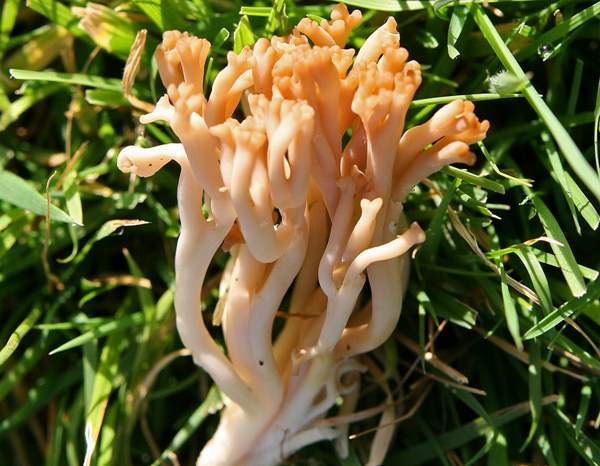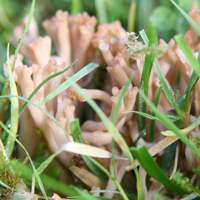Clavulinopsis umbrinella (Sacc.) Corner - Beige Coral
Phylum: Basidiomycota - Class: Agaricomycetes - Order: Agaricales - Family: Clavariaceae
Distribution - Taxonomic History - Etymology - Identification - Reference Sources

This lovely but rather rare coral fungus is found mainly in neutral or basic grassland. It is a fungus that is very easy to miss because it is often shorter than the grass in which it grows, although in side view the pale trunks and lower branches stand out well against the darker grass stems, from above it is less obvious.
When Bruce Ing produced the Red Data List of 1962, Beige Coral was included as 'Vulnerable'. Shelly Evans removed it from the 2006 list.
Distribution
Although widely distributed throughout Britain and Ireland, Beige Coral is an infrequent to rare find. This species is also reported from some mainland European countries, including France, and from parts of North America.
Taxonomic history
Although this species was first described by the British naturalist Miles Joseph Berkeley in 1860, he gave it an invalid (because the specific epithet had already used in an earlier publication and hence is a homonym) binomial scientific name Clavaria umbrina. The basionym for this coral fungus dates from 1888, when Italian mycologist Pier Andrea Saccardo described it and named it Clavaria umbrinella. It was another British mycologist, Edred John Henry Corner (1906 - 1996), who in 1950 transferred this species to the genus Clavulinopsis, at which point its currently accepted scientific name Clavulinopsis umbrinella was created.
Synonynms of Clavulinopsis umbrinella include Clavaria umbrina Berk., Clavaria umbrinella Sacc., Clavaria holmskjoldii Oudem., Clavulinopsis holmskjoldii (Oudem.) Corner, Clavaria cinereoides G.F. Atk., Clavulinopsis cinereoides (G.F. Atk.) Corner, Ramariopsis holmskjoldii (Oudem.) R.H. Petersen, and Ramariopsis umbrinella (Sacc.) R.H. Petersen.
Etymology
The origin of the generic name is the Latin noun clava meaning a club, with the suffix implying that it looks quite similar to species in the genus Clavulina. The Clavulinopsis genus is closely related to Clavulina and Clavaria, but fungi in the Clavulinopsis group have tougher, less brittle fruitbodies that are solid rather than hollow in structure. The most obvious microscopic difference is that Clavulinopsis species have clamp-connections in the tramal tissues.
The specific epithet umbrinella also comes from Latin. Umbr- means dark or shade, and the suffix -ella implies diminutive in stature. Little fungi of the shadows might therefore be one interpretation. Any other suggestions?
Identification guide
 |
FruitbodyBranching stems arising from a common thickened base; stems usually branch dichotomously each branch eventually terminating in two (but occasionally more) blunt tips; pinkish beige, maturing tan-brown; base paler. The individual clubs are typically 4 to 8cm tall. |
SporesSubglobose to pip shaped, smooth, 4-6.7 by 3-6μm; each containing a single droplet. Spore printWhite. |
|
Odour/taste |
Not distinctive. |
Habitat & Ecological role |
Saprobic, growing from the soil in short grassland. |
Season |
July to November in Britain and Ireland. |
Similar species |
Clavulinopsis fusiformis usually forms much more dense tufts; its yellowish clubs are laterally compressed and only occasionally forked. Clavulina coralloides is much paler and occurs beneath deciduous and coniferous trees; very often beside footpaths. |
Reference Sources
Fascinated by Fungi, 2nd Edition, Pat O'Reilly 2016, reprinted by Coch-y-bonddu Books in 2022.
Dictionary of the Fungi; Paul M. Kirk, Paul F. Cannon, David W. Minter and J. A. Stalpers; CABI, 2008
Taxonomic history and synonym information on these pages is drawn from many sources but in particular from the British Mycological Society's GB Checklist of Fungi.
Fascinated by Fungi. Back by popular demand, Pat O'Reilly's best-selling 450-page hardback book is available now. The latest second edition was republished with a sparkling new cover design in September 2022 by Coch-y-Bonddu Books. Full details and copies are available from the publisher's online bookshop...

